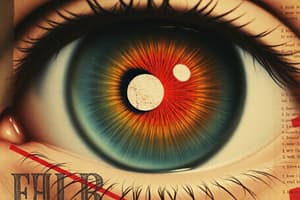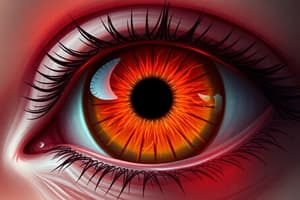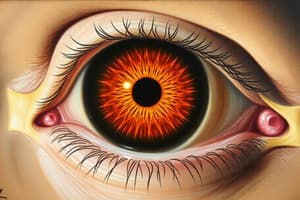Podcast
Questions and Answers
What is the main purpose of Object Detection in computer vision?
What is the main purpose of Object Detection in computer vision?
- Locating objects and their classifications within an image (correct)
- Classifying the entire image
- Labeling every pixel in the image
- Identifying only the primary object in the image
Instance segmentation labels every pixel in an image.
Instance segmentation labels every pixel in an image.
False (B)
What does IoU stand for in the context of object detection?
What does IoU stand for in the context of object detection?
Intersection over Union
The bounding box in object detection is defined by its coordinates (x, y, w, __________).
The bounding box in object detection is defined by its coordinates (x, y, w, __________).
Which of the following is a proposal-based algorithm for object detection?
Which of the following is a proposal-based algorithm for object detection?
Single Shot Detector (SSD) is a proposal-free algorithm.
Single Shot Detector (SSD) is a proposal-free algorithm.
Name one evaluation metric for object detection.
Name one evaluation metric for object detection.
Match the following algorithms to their categories:
Match the following algorithms to their categories:
What does the bbox subnetwork in the RetinaNet architecture do?
What does the bbox subnetwork in the RetinaNet architecture do?
The top-down pathway in RetinaNet merges the top-down and bottom-up layers.
The top-down pathway in RetinaNet merges the top-down and bottom-up layers.
What is the main advantage of using RetinaNet's focal loss in object detection?
What is the main advantage of using RetinaNet's focal loss in object detection?
The RetinaNet architecture uses a _______ subnetwork to predict the probability of an object being present at each spatial location.
The RetinaNet architecture uses a _______ subnetwork to predict the probability of an object being present at each spatial location.
Match the following components of the RetinaNet architecture with their functions:
Match the following components of the RetinaNet architecture with their functions:
Which of the following is an evaluation metric commonly used for object detection?
Which of the following is an evaluation metric commonly used for object detection?
Sliding window technique is considered efficient for detecting multiple objects in an image.
Sliding window technique is considered efficient for detecting multiple objects in an image.
What key aspect does Region Proposal Networks focus on in the context of object detection?
What key aspect does Region Proposal Networks focus on in the context of object detection?
What is the threshold value used in Non-Maximum Suppression (NMS) to reduce proposals?
What is the threshold value used in Non-Maximum Suppression (NMS) to reduce proposals?
Online hard example mining (OHEM) focuses on training the model using an equal number of easy and hard examples.
Online hard example mining (OHEM) focuses on training the model using an equal number of easy and hard examples.
What is the primary purpose of Non-Maximum Suppression (NMS) in object detection?
What is the primary purpose of Non-Maximum Suppression (NMS) in object detection?
In OHEM, the ratio of picked negatives to positives should be at most _____:1.
In OHEM, the ratio of picked negatives to positives should be at most _____:1.
Which of the following steps is NOT part of the Non-Maximum Suppression process?
Which of the following steps is NOT part of the Non-Maximum Suppression process?
Match the following components with their roles in object detection:
Match the following components with their roles in object detection:
How many anchors does Faster R-CNN select in its process?
How many anchors does Faster R-CNN select in its process?
Faster R-CNN is designed for real-time object detection.
Faster R-CNN is designed for real-time object detection.
Which of the following findings from the SSD model indicates the importance of varying detection techniques?
Which of the following findings from the SSD model indicates the importance of varying detection techniques?
YOLO approaches object detection by first performing classification on the entire image.
YOLO approaches object detection by first performing classification on the entire image.
What is one key advantage of the YOLO approach in object detection?
What is one key advantage of the YOLO approach in object detection?
In SSD, using multiple output layers at different __________ leads to better detection results.
In SSD, using multiple output layers at different __________ leads to better detection results.
Match the following techniques with their key features:
Match the following techniques with their key features:
Which metric can be used to evaluate the performance of multi-object detection algorithms?
Which metric can be used to evaluate the performance of multi-object detection algorithms?
Data augmentation has little to no effect on the performance of object detection models.
Data augmentation has little to no effect on the performance of object detection models.
What is the primary goal of using the sliding window technique in object detection?
What is the primary goal of using the sliding window technique in object detection?
What is a common technique used for object detection that involves scanning an image with a fixed-size window?
What is a common technique used for object detection that involves scanning an image with a fixed-size window?
Region Proposal Networks are part of the Faster R-CNN architecture.
Region Proposal Networks are part of the Faster R-CNN architecture.
Name one evaluation metric commonly used in object detection.
Name one evaluation metric commonly used in object detection.
The ____ algorithm enables detection of multiple objects within an image at once.
The ____ algorithm enables detection of multiple objects within an image at once.
Match the following object detection algorithms with their primary feature:
Match the following object detection algorithms with their primary feature:
Which of the following is a benefit of using Region Proposal Networks?
Which of the following is a benefit of using Region Proposal Networks?
The Sliding Window Technique is one of the least effective methods for object detection.
The Sliding Window Technique is one of the least effective methods for object detection.
What does SSD stand for in object detection algorithms?
What does SSD stand for in object detection algorithms?
Flashcards are hidden until you start studying
Study Notes
Computer Vision Tasks
- Image Classification: Assign a single label (class) to an entire image.
- Object Detection: Identify instances of objects along with their locations using bounding boxes (coordinates x, y, width, height).
- Semantic Segmentation: Classify each pixel in an image, providing a detailed label for every pixel.
- Instance Segmentation: Similar to semantic segmentation, but distinguishes between separate instances of the same class.
Object Detection Overview
- Combines classification (identifying "what") with localization (identifying "where").
- Utilizes fully-connected layers in CNNs to map features to class labels and bounding box coordinates.
Intersection over Union (IoU)
- A metric used to evaluate the overlap between predicted and actual bounding boxes.
- Optimizing IoU is crucial for improving detection accuracy.
Object Detection Datasets
- PASCAL VOC Challenge: A benchmark for recognizing objects from various classes in realistic scenes.
Proposal-Based Algorithms
- R-CNN: Introduces a region proposal network to enhance detection speed.
- Fast R-CNN: Improves R-CNN by using a single CNN to extract features from the entire image instead of from individual proposals.
- Faster R-CNN: Further improves speed and accuracy with a region proposal network integrated into the architecture.
Proposal-Free Algorithms
- Single Shot Detector (SSD): Allows for object detection in a single forward pass through the network, utilizing multiple default boxes at different scales.
- You Only Look Once (YOLO): Treats object detection as a regression problem, predicting bounding boxes and class probabilities in one evaluation of the entire image.
- RetinaNet: Addresses class imbalance through a focal loss function, optimizing training for dense object detection.
Online Hard Example Mining (OHEM)
- A technique to enhance model training by focusing on hard examples rather than simply balancing easy vs. hard examples.
- Adjusts sampling based on current losses, ensuring an effective mix of positive and negative samples.
Non-Maximum Suppression (NMS)
- A post-processing step to refine object detection by eliminating redundant bounding boxes after evaluating proposals based on IoU thresholds.
YOLO Methodology
- Divides images into a grid, predicts bounding boxes and probabilities using a single neural network.
- Recognized for exceptional speed; significantly faster than earlier models like R-CNN.
SSD Key Findings
- Emphasizes the importance of data augmentation and using multiple box shapes to improve detection across varied scales and aspect ratios.
RetinaNet Architecture
- Combines a bottom-up pathway for feature extraction and a top-down pathway for object classification and bounding box regression, enhancing performance across various scales.
Future of Object Detection
- Continues to evolve with advances in deep learning technology, promising improved accuracy and real-time detection applications.
Studying That Suits You
Use AI to generate personalized quizzes and flashcards to suit your learning preferences.



